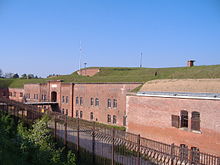Throat (fortress)
In fortress construction, the throat is the rear part of a detached fort (or work) (in front of the actual fortress).
When, towards the end of the 18th century, the method of fortification according to Vauban could no longer be used (the cost of this type of fortification - a new bastion ring was always placed around the existing bastion ring for reinforcement - the cost of the fortification increased), one began , instead to build self-sufficient Vorwerk in advance ( polygonal system ). These outworks were usually laid out in the basic form of an arch on the attack side and set up on this side for primary defense. The tendon of the bow was only weakly fastened (the attacking artillery could not normally act here - an exception was, for example, Fort Douaumont , where after its capture by the Germans the throat suddenly turned towards the enemy, i.e. the French) and hence the most vulnerable side of a fort - hence the name "throat". However, the fort was usually designed in such a way that its throat could just be reached and covered by a fort or core plant behind it with artillery or rifle fire.
Terms associated with the throat
Throat barracks
A building in a fort that closes off the rear side of the facility is referred to as a throat barracks. In this case, the building is designed as a barracks, with the possibility of close defense, as the access to the fortifications is often located here. In such a case, it can be assumed that the fort was constantly occupied with troops and was thus self-sufficient (well, powder magazine, power connection). From the throat barracks, the throat ditch, the drawbridge and the gun area in front of the drawbridge (if any) could be covered with gunfire.
Throat wall

For example, in three-quarter or semicircular works whose casemates served as barracks , the throat could also be closed by a simple wall.
In the case of lunettes , which sometimes only consisted of two earth walls running at an angle to each other, the throat was often only closed by a palisade or earth wall.
Throat ditch
Moat in the area of the throat. It is usually spanned by a drawbridge or, more rarely, by a removable bridge.
Throat suitcase
"Kehlkoffer" (derived from the French word "le coffre" = chest, box. In the older German fortress literature, however, a trunk was understood to be a trench cut open at the top; it stood in contrast to a caponier , which was closed.) is a term used in fortress construction and denotes a trench cut that is located in the throat of a fortress and is set up for cannon or rifle defense.
The task of a throat case is to defend the throat ditch and thus often also the access to the work in question. Even after the explosive grenades were developed in the mid-1880s, throat cases - now mostly made of concrete and steel - continued to be erected, while the remaining trenches were mainly built into the Contreescarpe. The main reason for keeping the Kehlkoffer was that the Kehlkoffer was turned away from the enemy and thus not threatened by the siege artillery , and the construction was simpler and cheaper, especially since the Kehlkoffer was a casemate in contrast to the one in the Contreescarpe (the outer wall of the trench) The trenches created did not require an access path ( postern ) leading under the floor of the trench . In addition, there was no longer the problem that a trench swipe in the outer wall of the trench was difficult to recapture because the enemy had in the meantime controlled part of the trench itself.
The term as such probably comes from the Austro-Hungarian military jargon and appears more and more in the description of the imperial and royal fortifications built from the second third of the 19th century on the border with Italy .
literature
- Hartwig Neumann : Fortress architecture and fortress construction technology. German defense architecture from the XV. - XX. Century. With a bibliography of German-language publications on fortress research and fortress use 1945–1987. 2nd Edition. Special edition. Bernard & Graefe, Bonn 1994, ISBN 3-7637-5929-8 , ( Architectura militaris 1).
Individual evidence
- ^ W. Riistow : Military concise dictionary based on the standpoint of the latest literature and with the support of experts. Volume 1: A - L. Schultheß, Zurich 1858, s. v. "Trench strokes" and s. v. "Suitcase".
- ↑ H. Blumhardt: The standing attachment for officers of all weapons and for war schools. According to the latest experiences and designs. Volume 1: The Doctrine of the Individual Parts of Fortification. Zernin, Darmstadt u. a. 1864, p. 86 ff., P. 126–195 (detailed description of trench strokes of all kinds); Bernhard von Poten : Concise dictionary of the entire military science. Volume 1/2: Aa to Döbeln. Velhagen & Klasing, Bielefeld u. a. 1877, p. v. Fortifications, Volume 3/4: Döffingen to Hyginus. Velhagen & Klasing, Bielefeld u. a. 1877/1878, s. v. "Trench Strokes", Volume 5/6: Ibrahim Pascha to the Military Convention. Velhagen & Klasing, Bielefeld u. a. 1878, p. v. Suitcase, see "" v. Capon, s. v. Casemates.


